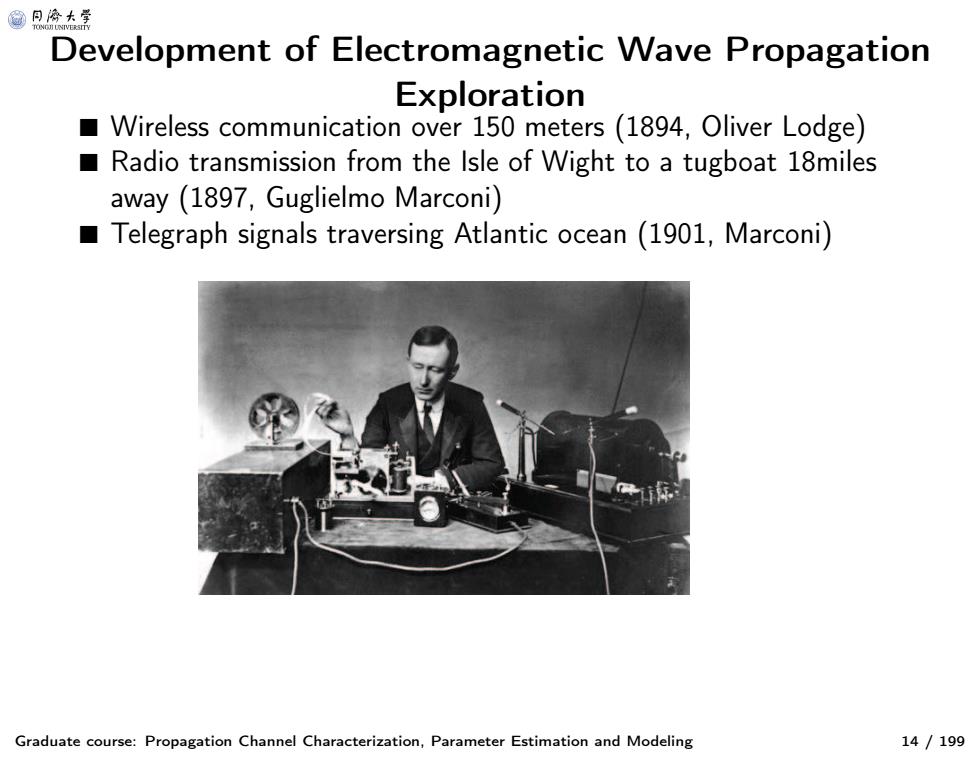
@月傍大学 Chapter 2 Characterization of Propagation Channels Graduate course:Propagation Channel Characterization,Parameter Estimation and Modeling 9/199
Graduate course: Propagation Channel Characterization, Parameter Estimation and Modeling 9 / 199 Chapter 2 Characterization of Propagation Channels

@月傍大学 Content Three Phenomena in Wireless Channel Path loss and shadowing Multipath fading Stochastic characterization of multipath fading Duality of multipath fading WSSUS assumption on multipath fading A review of propagation channel modelling Graduate course:Propagation Channel Characterization,Parameter Estimation and Modeling 11/199
Content Graduate course: Propagation Channel Characterization, Parameter Estimation and Modeling 11 / 199 ■ Three Phenomena in Wireless Channel ■ Path loss and shadowing ■ Multipath fading ■ Stochastic characterization of multipath fading ■ Duality of multipath fading ■ WSSUS assumption on multipath fading ■ A review of propagation channel modelling

@月命卡等 Development of Electromagnetic Wave Propagation Exploration Maxwell's equation:theory of electromagnetic propagation (1864, James Clerk Maxwell) Warld's Greatest rention Selentists 1000 2000 JAMES CLERK MAXWELL 1831-1879 Physics·Electrodynamics·Optics Statistical Thermodynamics MAXWELL'S EQUATIONS*of electromagnetism: Ushered in the age of radar,radio and TV Designed Cavendish Laboratory ● hoy o时wmng o First color photograph e Father of lern physics Cambridge scholar Exemplha3eghristihan 29 or workers ● Philosopher and poet against evolutionism awell's diseovery of the laws of electrodynamics. -Dr.Richard Feyuman,Nobel Lmeate in modem plrysics Teach us s to st udy the works of Thy hands 7B=0 and so to receive Thy blessed Word.that E=-架 ve may hellave ou him whom thou hast 7xH=+盟 sent to give us the knowledge of salvation and the remission of our sins." James Clerk Maxwell Graduate course:Propagation Channel Charac 12/199
Development of Electromagnetic Wave Propagation Exploration Graduate course: Propagation Channel Characterization, Parameter Estimation and Modeling 12 / 199 ■ Maxwell’s equation: theory of electromagnetic propagation (1864, James Clerk Maxwell)

@月冷大学 Development of Electromagnetic Wave Propagation Exploration ■ Demonstration of existence of electromagnetic waves (1887, Heinrich Hertz) eraer Den Graduate course:Propagation Channel Characterization,Parameter Estimation and Modeling 13/199
Development of Electromagnetic Wave Propagation Exploration Graduate course: Propagation Channel Characterization, Parameter Estimation and Modeling 13 / 199 ■ Demonstration of existence of electromagnetic waves (1887, Heinrich Hertz)

@月©大学 Development of Electromagnetic Wave Propagation Exploration Wireless communication over 150 meters (1894,Oliver Lodge) ■ Radio transmission from the Isle of Wight to a tugboat 18miles away (1897,Guglielmo Marconi) Telegraph signals traversing Atlantic ocean (1901,Marconi) Graduate course:Propagation Channel Characterization,Parameter Estimation and Modeling 14/199
Development of Electromagnetic Wave Propagation Exploration Graduate course: Propagation Channel Characterization, Parameter Estimation and Modeling 14 / 199 ■ Wireless communication over 150 meters (1894, Oliver Lodge ) ■ Radio transmission from the Isle of Wight to a tugboat 18mile s away (1897, Guglielmo Marconi) ■ Telegraph signals traversing Atlantic ocean (1901, Marconi)

@月冷大学 Development of Electromagnetic Wave Propagation Exploration Transmission of voice and music by amplitude modulation (1906, Regionald Fessenden) ffim.... WINS SUIT He'sFather of Radio' RAOO TRUST Reginald Fessenden Wins $2.5-million In 1928 Suit Graduate course:Propagation Channel Characterization,Parameter Estimation and Modeling 15/199
Development of Electromagnetic Wave Propagation Exploration Graduate course: Propagation Channel Characterization, Parameter Estimation and Modeling 15 / 199 ■ Transmission of voice and music by amplitude modulation (1906, Regionald Fessenden)

@月命大凳 Maxwell's equation Ultimate details of propagation can be obtained by solving Maxwell's equations with boundary conditions that express the physical characteristics of the obstructing objects,including the radar cross-section(RCS) of large and complex structures Difficulties lie in the non-availability of the parameters Resorting to the approximations to characterize signal propagation Graduate course:Propagation Channel Characterization,Parameter Estimation and Modeling 16/199
Maxwell’s equation Graduate course: Propagation Channel Characterization, Parameter Estimation and Modeling 16 / 199 ■ Ultimate details of propagation can be obtained by solving Maxwell’s equations with ◆ boundary conditions that express the physical characteristics of the obstructing objects, including the radar cross-section (RCS) of large and complex structures ■ Difficulties lie in the non-availability of the parameters ■ Resorting to the approximations to characterize signal propagation

@月冷大等 Channel as a challenge .. Susceptible to noise,interference and channel impediments ■ Changing over time in unpredictable ways,due to ◆User movement Environment dynamics h(t) Specular path Path Receiver y(t) Path D w(t) s(t)o Transmitter Dispersive path y(t)=s(t)*h(t)+w(t) time,frequency,space,... time,frequency,space,... TDD OFDM MIMO delay Doppler directions Graduate course:Propagation Channel Characterization,Parameter Estimation and Modeling 17/199
Channel as a challenge ... Graduate course: Propagation Channel Characterization, Parameter Estimation and Modeling 17 / 199 ■ Susceptible to noise, interference and channel impediment s ■ Changing over time in unpredictable ways, due to ◆ User movement ◆ Environment dynamics Transmitter Path 1 Path D Specular path Receiver Dispersive path time, frequency, space, ... TDD OFDM MIMO time, frequency, space, ... delay Doppler directions s ( t ) h ( t ) w ( t ) y ( t ) y ( t) = s ( t ) ∗ h ( t) + w ( t )

@月命大凳 Characterizing Channel simply Variation in received signal power -30 35 40 子 0 5 60 65 -7 141516171819202122232425262728 T-R Separation (meters) Dimension:distance from the transmitter ■Phenomena include ◆Path loss ◆Shadowing ◆Multipath fading Graduate course:Propagation Channel Characterization,Parameter Estimation and Modeling 18/199
Characterizing Channel simply Graduate course: Propagation Channel Characterization, Parameter Estimation and Modeling 18 / 199 ■ Variation in received signal power ■ Dimension: distance from the transmitter ■ Phenomena include ◆ Path loss ◆ Shadowing ◆ Multipath fading

@月冷大等 T"⑧ Some examples of models ■ Simplest model:free-space path loss T ■ Ray-tracing propagation models: Small number N of multipath components Known Geometry and dielectric properties T⑧ Empirical models:parameters based on measurements Simple generic model:few parameters Log-normal model:for shadowing ■ Statistical multipath models:large N,unknown env. Tx trolley Rx trolley Tx/Rx Array Graduate course:Propagation Channel Characterization,Parameter Estimation and Modeling 19/199
Some examples of models Graduate course: Propagation Channel Characterization, Parameter Estimation and Modeling 19 / 199 ■ Simplest model: free-space path loss ■ Ray-tracing propagation models: ◆ Small number N of multipath components ◆ Known Geometry and dielectric properties ■ Empirical models: parameters based on measurements ■ Simple generic model: few parameters ■ Log-normal model: for shadowing ■ Statistical multipath models: large N, unknown env. Tx trolley Rx trolley Tx/Rx Array